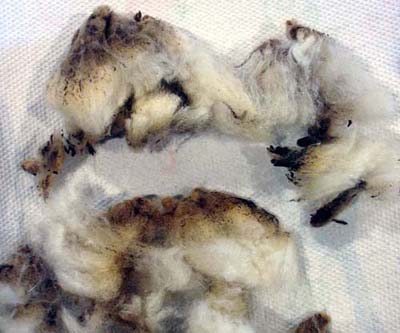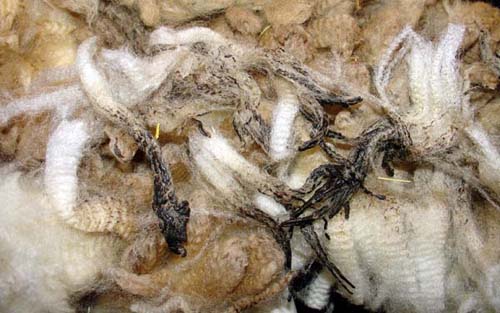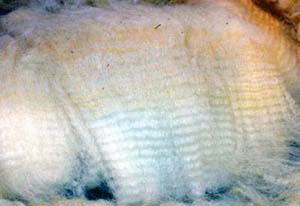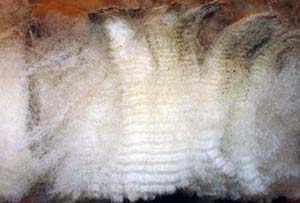This is a tutorial on skirting a fleece, and learning to recognize the parts of a fleece.
For basic information on skirting, please read this
page.
That page is an over view of what is involved in fleece skirting.
On this page, we hope to say more about the parts of the fleece that should be removed. During shearing, most of the belly, head, legs, and some of the neck wool are removed.

|

|
In this first set of photos the fleece is laid out on the skirting table, ready to skirt.
Notice the neck wool, below the black line, in the bottom of the photo on the right.

|
Here is a closer look at neck wool ... full of hay bits, or VM, vegetable matter. When a sheep is "coated", or wears a coat from shearing to shearing, there is the distinct line of the neck edge of the coat. All of the neck wool that is not under the coat, and most of the chest wool that WAS under the coat will be discarded. The neck wool because it is full of VM, and the chest wool because it has been rubbed by wearing the coat, and is likely felted, matted or "cotted".After the neck wool has been removed, if you will go to the opposite side of the fleece, you are going to find the tail, or "dock" of the fleece. All of the dock wool should be removed, as it contains urine and poop. (At least in a ewe fleece. A ram fleece has the most urine mid-belly) |

|

|
Along the bottom sides of the fleece are where you are likely to find any remaining belly wool. It has the shortest staple wool of any of the fleece and has (usually) very fine crimp, or no crimp. It will be very dirty, and may have burrs.

|
It's very important to remove all of the "sweat locks". These are the greasy locks from around/under the legs and tail. These locks are especially hard to see in a black fleece and you almost have to skirt by touch. Try to locate where each of the four legs would have been. Here you will find the sweat locks ... locks covered in black, grease. |

|

|

|
These three photos show locks from the shoulder, sides and back, and flank wool. It is not uncommon for a fleece to drop in grade from the shoulder to the flank wool.
(For a complete explanation of wool grades and wool grading systems see our
page
here.)
It is also likely that the shoulder wool will be a bit longer in staple than the flank wool.
The fleece used here is quite uniform in grade and staple length from shoulder to flank (so not a very good example of how these parts may be different)
There will be some dirt penetration along the lower sides, flank and shoulder wools.
Its not quite so beautiful as the spotlessly clean parts, but can be quite successfully cleaned at home by the hand spinner.
There is an unfounded belief that soaking grease fleece in cold water (WITHOUT SOAP) will somehow remove dirt, and grease from a fleece.
This is not the case, any more than washing dirty dishes, or clothes, or you own hair, in cold water without soap will get them clean. Sheep spend their entire lives outside, in fields or perhaps some time in a barn. They lay down where they have urinated and pooped. They don't bathe, ever.
In the fleece, there is a year's accumulation of everything they may have eaten or laid in. If cold water without soap was going to get a sheep clean, then standing in the rain or snow would get them clean. It doesn't.
Washing the wool as described on our
page
here, will get the grease fleece clean.

|

|
The last photos show the skirted fleece with all of the dirty wools removed. Hopefully, you can see that there is a difference after skirting?

The final photo is of the fleece rolled up and ready for sale.
Here's hoping you find your hands in grease fleece often!
[an error occurred while processing this directive]